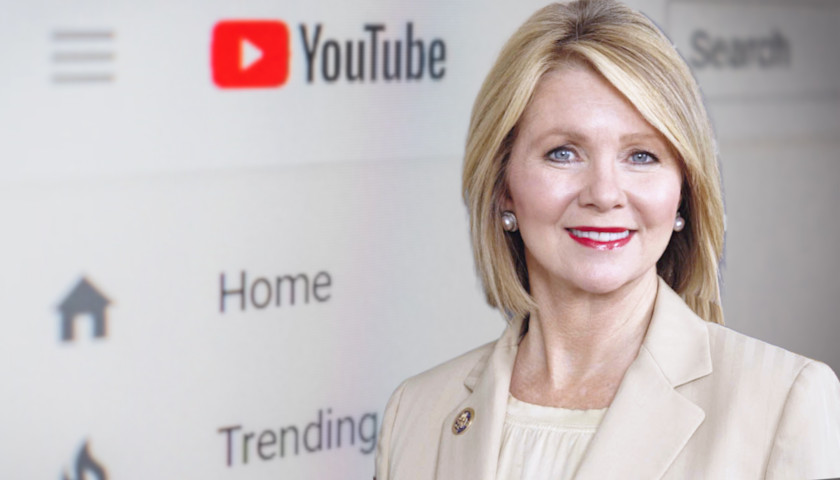U.S. Sen. Marsha Blackburn (R-TN) joined other senators in asking YouTube’s parent company Google to expand its copyright infringement technology to more members of the creative community, including those in Nashville.
Blackburn, a member of the Senate Judiciary Committee, joined U.S. Sens. Thom Tillis (R-NC), Chris Coons (D-DE) and Dianne Feinstein (D-CA) in making the request, according to a press release from her office. The senators sent a letter to Google CEO Sundar Pichai, asking him to expand Content ID, YouTube’s copyright infringement technology.
According to Google’s website on Content ID, copyright owners can use the system to identify and manage their content on YouTube.
Videos uploaded to YouTube are scanned against a database of files that have been submitted to us by content owners.
Copyright owners get to decide what happens when content in a video on YouTube matches a work they own. When this happens, the video gets a Content ID claim.
The senators asked that YouTube representatives participate in a roundtable to answer their questions. Tillis and Coons serve as chair and co-chair, respectively, of the Judiciary Subcommittee on Intellectual Property.
Blackburn said, “Google has demonstrated an interest in protecting original content on YouTube. However, by limiting the use of Content ID to more popular users, Google hinders copyright holders with smaller catalogs from reaping the benefits of its actions. Talented creators, including Nashville’s songwriting community, are disproportionately at risk of infringement.”
Also involved are U.S. Reps. Jerrold Nadler (D-NY-10), Doug Collins (R-GA-09), Adam Schiff (D-CA-28) and Martha Roby (R-AL-02).
The contents of the letter follow.
Dear Mr. Pichai:
We write today regarding Google’s efforts related to platform responsibility in the digital environment. Over the last year, Google has appeared before multiple House and Senate committees to discuss this issue. In response to questions from our congressional colleagues regarding efforts Google is taking to stem widespread distribution of infringing content, you have routinely pointed to YouTube’s “Content ID” system as an example.
YouTube Content ID is described as a “strong set of tools to prevent copyright infringing material from appearing.” We understand that Content ID is a technology developed by Google and voluntarily made available to creators. We appreciate Google’s efforts to combat the illegal distribution of content on YouTube.
It has also come to our attention that access to the Content ID system is only granted to companies that “own exclusive rights to a substantial body of original material that is frequently uploaded by the YouTube user community.” We are concerned that copyright holders with smaller catalogs of works cannot utilize Content ID, making it more difficult or impossible for them to effectively protect their copyrighted works from infringement and, ultimately, impacting their livelihoods. We have heard from copyright holders who have been denied access to Content ID tools, and as a result, are at a significant disadvantage to prevent the repeated uploading of content that they have previously identified as infringing. They are left with the choice of spending hours each week seeking out and sending notices about the same copyrighted works, or allowing their intellectual property to be misappropriated.
The core copyright industries in the United States provide over 5.7 million jobs and generate $1.3 trillion toward the country’s gross domestic product, accounting for 6.85% of the U.S. economy.
Preserving these industries is of great importance to our economy and to our nation’s ability to compete internationally. Given the significant impact this technology could have on these industries and the creators that are at their heart, we respectfully request your participation in a roundtable with Congressional offices and members of the creative community to discuss the following questions and issues.
1. In general, how does the Content ID technology work? Compared to other available mechanisms for rights holders to identify potentially infringing works on Google’s platforms, how much day-to-day involvement of rights holders is needed?
2. How do the user and Google work together to identify and block illegal material? To what extent is Content ID dependent upon user engagement and interaction?
3. Please describe generally which types of rights holders currently are permitted to use Content ID, including how Google assesses whether a rights holder owns a “substantial body of original material” and whether such material is “frequently uploaded.”
a. How often does a piece of content need to appear on YouTube in order to be considered a “frequently uploaded” work?
b. Is “frequently uploaded” an absolute or relative measure?
4. Please describe any terms and conditions related to the use of Content ID.
5. Other than YouTube, on what Google platforms is Content ID used to identify and block infringing material? For example, do you use it to block the distribution of infringing material on Blogger, Google Photos, and Google Drive, among others? If not, do you plan to implement Content ID or similar safeguards on these platforms?
6. Does Google plan to provide access to Content ID to a larger number of rights holders? If so, when? If not, what challenges prevent you from doing so?
We ask that you reply by October 30, 2019 with a date for this roundtable, which will be no later than the end of the 2019 calendar year. Again, we appreciate the efforts that you have made to combat distribution of infringing content on YouTube. Given its apparent benefits to rights holders, we hope that you will consider making Content ID and the benefits it provides available to a larger category of content creators. If you have any questions, please do not hesitate to contact us.
– – –
Jason M. Reynolds has more than 20 years’ experience as a journalist at outlets of all sizes.









For anyone who wants to use Twitter for their business, I’ll let you in on a secret: buying Twitter followers is the best marketing strategy. You have the potential to gain hundreds or even thousands of clicks once you boost your engagement. However, getting the results you want all comes down to the social media enhancement provider you choose. But don’t worry, Buy Twitter Followers Review has got you covered. Check their website to know more about the best sites for growing your follower base.